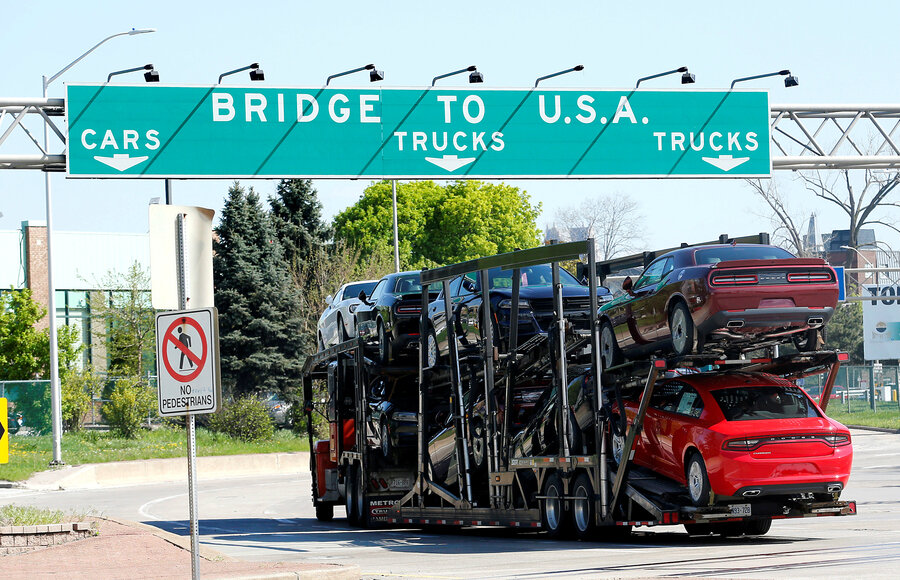NAFTA 2.0: what the Trump-brokered deal may mean
Loading...
With agreed-upon revisions to NAFTA this fall, the realm of global trade is looking a little less chaotic than it did before. The accord could foreshadow additional dealmaking, although big questions linger about the US-China relationship.
Q: What was the push to revise NAFTA all about?
During his election campaign and as president, Donald Trump ridiculed the 1994 North American Free Trade Agreement as the “worst trade deal ever.” Yet from business leaders to economists, many observers see the three-way trade deal as more beneficial than harmful. Still, Mr. Trump’s epithet symbolizes his broader critique: that too often the US has been on the losing end of deals to expand international commerce.
For the past year, US negotiators pressed Mexico and Canada for concessions. A last-minute compromise was reached Sept. 30, as Trump was warning the Canadians that the US would move forward without them and consider just a US-Mexican deal.
Q: When will the new deal take effect?
It’s not a sure thing yet, actually. A formal signing by the three heads of state still lies ahead. And then it needs approval by legislative bodies in all three nations, which may occur by early 2019.
Q: How dramatic are the changes?
The changes are more modest than revolutionary. Trump says the United States-Mexico-Canada Agreement (USMCA), which replaces NAFTA, will create factory jobs in the US and help all three economies. He won provisions including “rules of origin” that are designed to keep more automaking in the US.
Some of his critics say what didn’t happen is what’s most important. Most of NAFTA is set to remain in place, ending uncertainty about whether Trump would try to pull the US out of NAFTA without a viable replacement. Financial markets breathed a sigh of relief.
Q: What does all this say about Trump’s style of trade bargaining?
Perhaps foremost, that he’s ready to cut deals. He’s done so with South Korea, too, and talks are under way with Japan and the European Union. “If I were the Chinese, I’d be thinking, ‘Hmm, the Americans are capable of making deals – and they’re capable of [giving up] their most outrageous demands if they get something serious and substantive in return,’ ” William Reinsch, a trade expert at the Center for Strategic and International Studies in Washington, said in October as the deal was announced.
But if Trump’s style is often threaten first, compromise later, the question is whether that pattern will hold with Beijing. China’s size and its alleged unfair practices make it the toughest trade case for Trump.
A trade war between the world’s two largest economies, pushing up prices and rattling global supply chains, could dent economic growth worldwide.
The US administration appears to be betting that tariff pressure will ultimately force China toward big concessions, Edward Alden, a Washington-based trade expert at the Council on Foreign Relations, told the Monitor. But he added that “the longer this goes on with no serious negotiations, the less likely it is that a negotiation will be possible.”
Trump will meet with with Chinese President Xi Jinping in late November at the Group of 20 summit in Buenos Aires, but investors remain on edge over whether the two sides can make progress on disputed issues.
Q: Will the USMCA bring more US jobs?
Trump says yes, but some economists say the effects may not be noticeably up or down. Autos are an industry to watch. To be tariff-free, much of each car must be made by North American workers earning at least $16 an hour (read: US or Canadian workers). And 75 percent of the car’s value must come from North America, up from 62.5 percent under the old agreement.
Meanwhile, the now-low tariff on cars could jump if the administration follows through on threats to boost it by citing national security interests.
Even if US autoworkers gain, costs of cars could rise, creating uncertainty about the overall economic effects.
Q: Is Trump standing for free trade principles?
It’s complicated. On the one hand, Trump is anti-globalist. His blustery bargaining style amounts to managing trade rather than pushing for lower barriers at all times. Indeed, he’s willing to raise tariffs, as is now happening with China, even if that imposes higher costs on US consumers. And his “America First” approach has pushed other nations toward their own bilateral deals with one another.
On the other hand, he’s also said he’d welcome zero tariffs between the US and EU. The USMCA would liberalize the farm trade, enabling US farmers to sell more into Canada’s dairy market, while Canadian farmers could compete more with US sugar producers.
On labor, Trump may help level the field through a provision demanding true union organizing power for Mexican workers.
Although Trump has picked some favored industries like steel, his deals aren’t all about the “old economy.” They include, for example, efforts to modernize intellectual property rules for the digital economy.





